
 The Game: It’s like Namco Museum in the palm of your hand: some of the venerable Japanese arcade innovator’s all-time best quarter-grabbers from the 1980s are gathered in the form of a standalone joystick that plugs into your TV or VCR’s A/V jacks. Games built into this system are Pac-Man, Galaxian, Rally-X, Bosconian and Dig Dug. Batteries are not included, but the fun is. (Jakks Pacific [under license from Namco], 2003)
The Game: It’s like Namco Museum in the palm of your hand: some of the venerable Japanese arcade innovator’s all-time best quarter-grabbers from the 1980s are gathered in the form of a standalone joystick that plugs into your TV or VCR’s A/V jacks. Games built into this system are Pac-Man, Galaxian, Rally-X, Bosconian and Dig Dug. Batteries are not included, but the fun is. (Jakks Pacific [under license from Namco], 2003)
 Memories: After I reviewed the dandy Techno Source Intellivision 25-in-1 TV Game, at least one e-mail suggested that I wasn’t being critical enough in my review. I praised that dandy self-contained gadget for capturing the flavor of those 25 classic Intellivision games, even if a lot of the finer details were left out. Those of you who thought I was going easy on that game should just stop reading this review now. Because I kinda dig this quintet of Namco goodness – with some significant reservations.
Memories: After I reviewed the dandy Techno Source Intellivision 25-in-1 TV Game, at least one e-mail suggested that I wasn’t being critical enough in my review. I praised that dandy self-contained gadget for capturing the flavor of those 25 classic Intellivision games, even if a lot of the finer details were left out. Those of you who thought I was going easy on that game should just stop reading this review now. Because I kinda dig this quintet of Namco goodness – with some significant reservations.
 The physical package of the game itself is a small, faux-arcade-style joystick, complete with the big red ball on the top – just the way it should be, if you’re like me and played arcade games back when most of them did have the big red ball joystick. A single action button is positioned to the left of the joystick, almost like an Atari 2600 joystick. The battery compartment – holding 4 AAs – is on the bottom of the unit, and the A/V cables emerge from the back. It’s a slightly bulky device, but it’s just as easily held in your hands as place on a tabletop.
The physical package of the game itself is a small, faux-arcade-style joystick, complete with the big red ball on the top – just the way it should be, if you’re like me and played arcade games back when most of them did have the big red ball joystick. A single action button is positioned to the left of the joystick, almost like an Atari 2600 joystick. The battery compartment – holding 4 AAs – is on the bottom of the unit, and the A/V cables emerge from the back. It’s a slightly bulky device, but it’s just as easily held in your hands as place on a tabletop.
On power-up, the unit presents a dandy little graphical menu, complete with animated characters and a logo for each game. Pac-Man gets first billing on the unit’s packaging, and it’s the first game on the menu. And it’s a beautiful thing – this is what 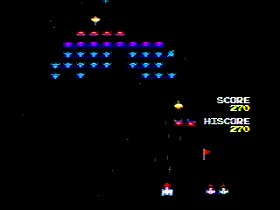 Pac-Man should’ve been like on Namco Museum. No goofy, gaudy border with the artwork to the original Japanese Puck-Man coin-op. No tiny screen display. The playfield is big and easy to see, and the score, fruit and lives and displayed in empty area remaining to the right of the vertical playfield. The colors and characters all look just right, and the full arcade attract mode is there too. The only thing that’s even slightly “off” with Pac-Man is the sound…but it’s not so “off” as to detract from my enjoyment of the game. It’s close enough for government work, but not so far away from the real deal as to beg comparisons to Atari 2600 Pac-Man. The same applies to Galaxian – everything looks and plays just right, only the sounds are something like an octave lower than they should be.
Pac-Man should’ve been like on Namco Museum. No goofy, gaudy border with the artwork to the original Japanese Puck-Man coin-op. No tiny screen display. The playfield is big and easy to see, and the score, fruit and lives and displayed in empty area remaining to the right of the vertical playfield. The colors and characters all look just right, and the full arcade attract mode is there too. The only thing that’s even slightly “off” with Pac-Man is the sound…but it’s not so “off” as to detract from my enjoyment of the game. It’s close enough for government work, but not so far away from the real deal as to beg comparisons to Atari 2600 Pac-Man. The same applies to Galaxian – everything looks and plays just right, only the sounds are something like an octave lower than they should be.
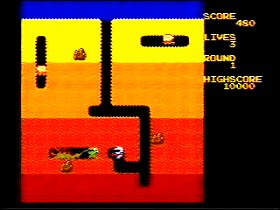 With Dig Dug, one begins to see a few changes. Unlike that game on Namco Museum, the playfield doesn’t exhibit the slight vertical scrolling; instead, the action is confined only to that screen. The sound in Dig Dug is vastly simplified – this time it’s quite a way off from the original. There’s also some sprite flicker – something I’m not use to seeing in any kind of modern game system – with Fygar’s flaming breath and Galaxian‘s laser blasts. And from here on out, things really change.
With Dig Dug, one begins to see a few changes. Unlike that game on Namco Museum, the playfield doesn’t exhibit the slight vertical scrolling; instead, the action is confined only to that screen. The sound in Dig Dug is vastly simplified – this time it’s quite a way off from the original. There’s also some sprite flicker – something I’m not use to seeing in any kind of modern game system – with Fygar’s flaming breath and Galaxian‘s laser blasts. And from here on out, things really change.
Both Rally-X and Bosconian originally hit the arcades with horizontally-oriented screens, programmed to display their playing fields in the 4:3 ratio of a normal TV or monitor. So it just follows that these would be, of everything included here, the easiest and most authentic game translations, right?
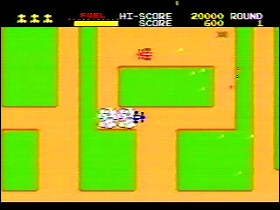 Wrong. Both games set aside part of their non-playing-field screen space for radar displays, tracking the big picture of where you and your enemies are – at least in the arcade and on such previous releases as Namco Museum Volume 1. Here, however, the playing fields are expanded (and somewhat “letterboxed”) so that they takes up the entire screen. And the radar? The data from the radar is overlaid on the action, since in this new format it has nowhere else to go. (This is best demonstrated by the Rally-X screen shot seen here; see all those dots hanging over the right half of the screen?) I’ll admit, I plugged the Namco 5-in-1 unit in and started playing it cold without going through the docs, so this caught me by surprise and, especially in Bosconian‘s case, actually disoriented me – the radar display looks like it might be enemy fire, and more than once I hastily backed off of an approaching pixel of something and ran head-first into real trouble before realizing that I was running away from a blip on the radar, but not something actually near me on the playing field. Bosconian is challenging enough without the machine throwing me a screwball curve like that.
Wrong. Both games set aside part of their non-playing-field screen space for radar displays, tracking the big picture of where you and your enemies are – at least in the arcade and on such previous releases as Namco Museum Volume 1. Here, however, the playing fields are expanded (and somewhat “letterboxed”) so that they takes up the entire screen. And the radar? The data from the radar is overlaid on the action, since in this new format it has nowhere else to go. (This is best demonstrated by the Rally-X screen shot seen here; see all those dots hanging over the right half of the screen?) I’ll admit, I plugged the Namco 5-in-1 unit in and started playing it cold without going through the docs, so this caught me by surprise and, especially in Bosconian‘s case, actually disoriented me – the radar display looks like it might be enemy fire, and more than once I hastily backed off of an approaching pixel of something and ran head-first into real trouble before realizing that I was running away from a blip on the radar, but not something actually near me on the playing field. Bosconian is challenging enough without the machine throwing me a screwball curve like that.
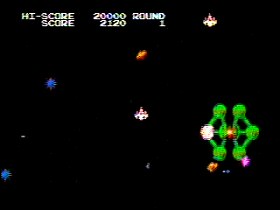 So the overall verdict? I got this mainly to play Pac-Man and Dig Dug. I can overlook the changes made to those games because it only affects them in a minor audiovisual sense; indeed, this machine plays Pac-Man the way I wish I could play it on the Playstation. But the changes made to Rally-X and Bosconian alter the whole dynamic of the game – suddenly you’re having to decipher radar data amidst a sea of scrolling play area, which is itself awash with animated enemies. You’re forced to take your eyes off the main action to try to keep track of minor details that become visually obscured, and that’s not the kind of challenge I look for in a video game, old or new. I give Jakks Pacific a lot of credit for even attempting this audacious translation; previous all-in-one units have emulated the Atari 2600 and the
So the overall verdict? I got this mainly to play Pac-Man and Dig Dug. I can overlook the changes made to those games because it only affects them in a minor audiovisual sense; indeed, this machine plays Pac-Man the way I wish I could play it on the Playstation. But the changes made to Rally-X and Bosconian alter the whole dynamic of the game – suddenly you’re having to decipher radar data amidst a sea of scrolling play area, which is itself awash with animated enemies. You’re forced to take your eyes off the main action to try to keep track of minor details that become visually obscured, and that’s not the kind of challenge I look for in a video game, old or new. I give Jakks Pacific a lot of credit for even attempting this audacious translation; previous all-in-one units have emulated the Atari 2600 and the 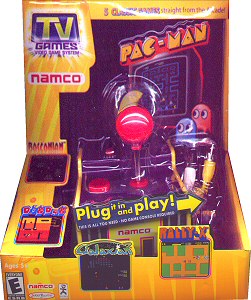 Intellivision, both much simpler machines than their contemporaries in the arcades – and I’d go so far as to say the 3/5 of the Namco 5-in-1 TV Game hit a lot closer to the mark than those previous machines did, and it’s emulating more complex hardware. But I do have to count points off for 2/5 of the machine’s offerings being rendered almost unplayable.
Intellivision, both much simpler machines than their contemporaries in the arcades – and I’d go so far as to say the 3/5 of the Namco 5-in-1 TV Game hit a lot closer to the mark than those previous machines did, and it’s emulating more complex hardware. But I do have to count points off for 2/5 of the machine’s offerings being rendered almost unplayable.
But again, going back to what I said about that Intellivision multigame, it’s an incredibly cool idea, and I have to give them credit for almost pulling it off. The games look incredible, and once you take the time to get used to the altered displays, they play well. And the alterations I’ve described to these games, while they throw someone like me for a major loop, someone  who’s grown accustomed to the original play mechanics via Namco Museum and MAME…those changes may not matter to someone who hasn’t seen any of these games in 20 years. I still give it a hearty recommendation, especially as a gift to someone outside of the hardcare retro video gaming hobby.
who’s grown accustomed to the original play mechanics via Namco Museum and MAME…those changes may not matter to someone who hasn’t seen any of these games in 20 years. I still give it a hearty recommendation, especially as a gift to someone outside of the hardcare retro video gaming hobby.
